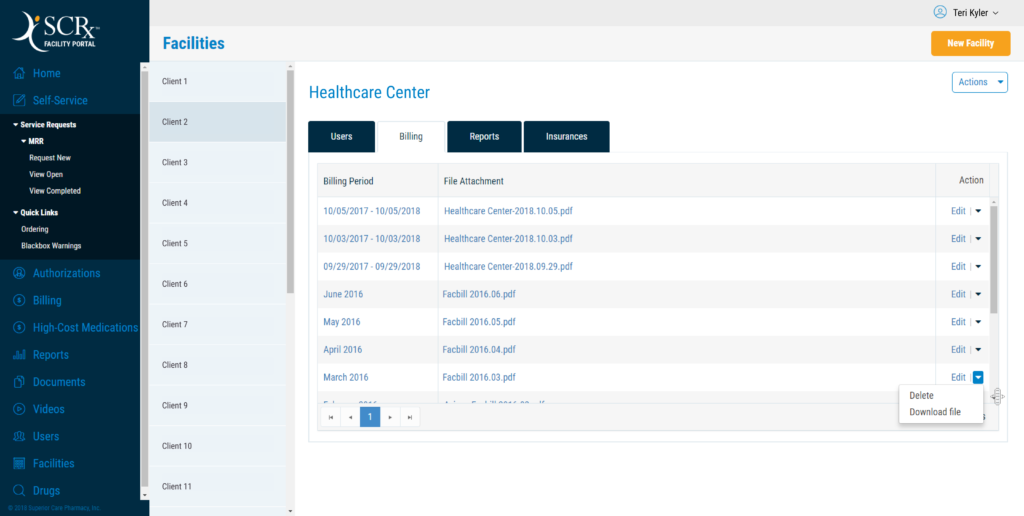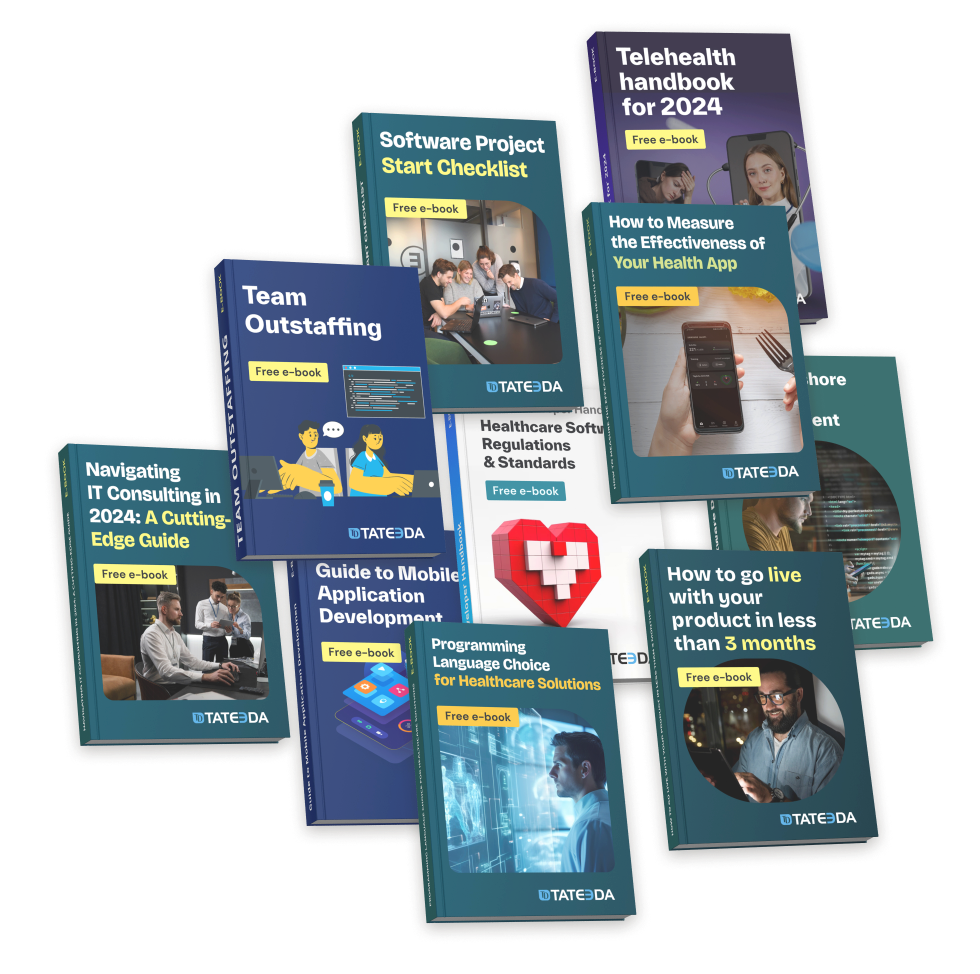Healthcare IT Stats, Market Size, and Trends in the United States [2025]

This article reviews healthcare technology statistics for 2025 and beyond, providing valuable insights for healthcare stakeholders—including medical company administrators, clinicians, digital health experts, investors, and others—to stay informed and seize opportunities in this ever-growing sector.
After reading this article and considering the healthcare IT market analysis offered, you’ll gain valuable insights to decide if investing in this sector aligns with your goals. In 2021, investor funding in digital health peaked at nearly $45 billion, doubling the previous year, while 2022 saw $23.3 billion—still the second-highest annual figure since 2010. Looking ahead to 2025, the healthcare IT market is projected to regain momentum, with growth expected to surpass previous milestones and set new records, reflecting the sector’s resilience and continuous innovation.
| Why Are We Confident in Discussing Healthcare Technology Market Stats? TATEEDA is a custom healthcare software development company based in San Diego ??? and has been active since 2013. We are highly experienced in HIPAA and CCPA compliance and have collaborated with numerous U.S.-based healthcare organizations, including one of the largest travel nurse providers, pharmaceutical distribution businesses, biotech firms, and clinics. If you need immediate consulting, please let us know ⇒ |
The healthcare IT market share is on a rapidly growing trajectory, as illustrated in the chart below: It is expected to double from roughly $360 billion in 2024 to over $730 billion by 2029, with an annual growth rate of 15%. But what’s driving this surge, and why should investors and technology enthusiasts care?
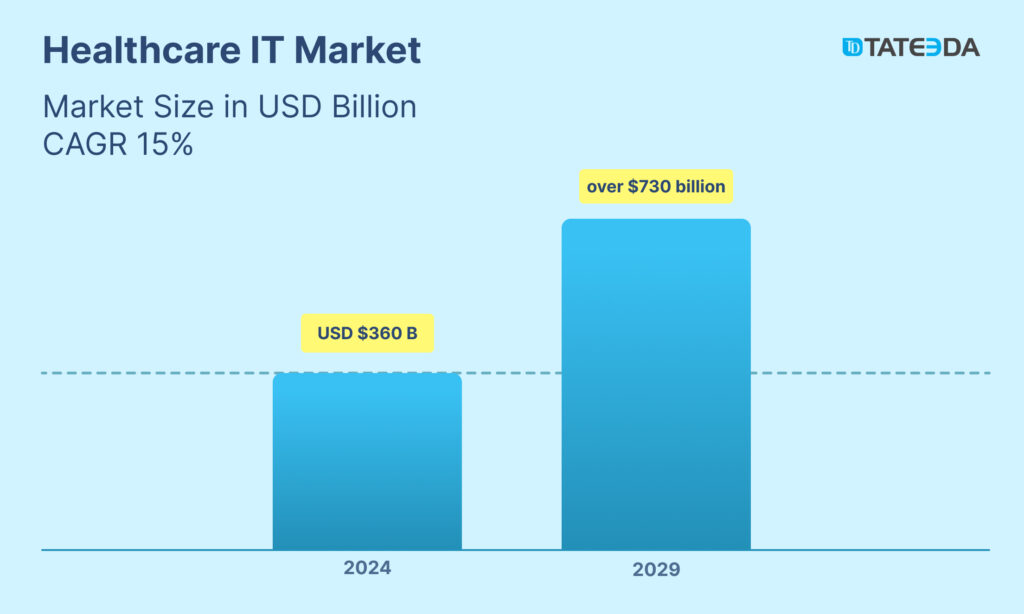
Table of Contents
How Digital Health Statistics Reflect Growing Healthcare Innovation
This reflects how the expanding top-notch healthcare technology market size encompasses the immense value of diverse sectors and innovations, reaching unprecedented heights and transforming the way healthcare functions today.
“The healthcare information technology market size is skyrocketing as digital solutions weave deeper into every aspect of U.S. healthcare. It’s incredible to see how quickly this field is evolving both in the United States and globally, with heavyweight investors shaping innovations that are transforming patient care forever.”
— Anastasia M., TATEEDA’s Tech Team Lead
- Telemedicine Platforms: Estimated to exceed $115 billion in 2024, custom telemedicine solutions and platforms are more than just tools for virtual consultations—they’re lifelines in underserved areas. These platforms enable real-time communication and seamless data sharing between patients and healthcare providers by integrating secure messaging protocols and data integration layers. “Recent Telemedicine technologies have become the connective tissue for healthcare delivery, bridging gaps that once seemed insurmountable,” says Andrew G., Senior Developer at TATEEDA.
- Electronic Health Records (EHRs): Centralized EHR systems, adopted by 88% of U.S. office-based physicians, have evolved into dynamic tools for analyzing trends and improving care. These systems enhance chronic disease management and streamline care coordination by featuring advanced data visualization dashboards and population health management solutions. With built-in data de-identification tools, patient privacy is safeguarded without compromising accessibility.
- Patient Portals: Empowering patients has never been simpler—or more secure. These custom patient portal solutions, underpinned by healthcare SaaS platforms, offer features such as appointment scheduling, test result access, and communication with clinicians. Biometric authentication ensures robust security, while patient consent management makes sharing sensitive information a breeze. As these tools grow in popularity, their role in boosting patient engagement becomes increasingly pivotal.
- AI-Driven Diagnostics: AI has firmly rooted itself in healthcare, with its market estimated at $9+ billion in 2024 and climbing. AI-powered telehealth and diagnostic tools leverage clinical decision support (CDS) systems and natural language processing (NLP) to detect diseases earlier and with greater accuracy. Solutions such as digital pathology systems and augmented reality (AR) surgery assistance are taking diagnostics—and patient care—to unprecedented levels of precision.

- Cloud-Based Data Storage: The healthcare cloud computing sector, valued at around $40+ billion in 2024, exemplifies scalability and efficiency. Equipped with big data pipelines, cloud platforms enable secure storage and quick access to critical medical data. Medical imaging archives are becoming indispensable tools for healthcare institutions, streamlining diagnostic processes and ensuring compliance with stringent healthcare regulations.
- Custom Telepharmacy Solutions and Pharma App Development: Telepharmacy systems are redefining patient care by integrating cloud-based formularies and digital dispensing systems — innovations that have reduced prescription error rates by over 40%. The global telepharmacy market is projected to reach $27.36 billion by 2029, driven by advancements in digital prescription technology and real-time patient data analytics. These innovations enhance drug safety monitoring and adherence, ensuring that remote patients receive both efficacious and compliant healthcare. Moreover, online pharmacy app features utilize cryptographic security measures to safeguard sensitive health information, aligning with stringent regulatory frameworks and bolstering patient trust.
- Cybersecurity Solutions: With interconnected systems dominating the healthcare IT landscape, cybersecurity has become the foundation of trust. Chronic disease management platforms and clinical workflow automation rely on robust safeguards, supported by a healthcare cybersecurity market that surpassed $12 billion in 2020. These measures protect sensitive data, reduce risks, and ensure regulatory compliance.
“Since the digital shift of the early 2020s, Healthcare IT has really taken center stage. Cloud technology, AI, and big data are now at the heart of healthcare, changing the game in how we manage care. From maintaining electronic health records to monitoring patients remotely or securing data with AI, these innovations enable healthcare providers to handle large volumes of data with much greater speed and security.”
— Slava K., CEO of TATEEDA
| Challenges | Opportunities |
| High Maintenance Costs | With escalating expenses tied to system upkeep and updates, companies can seize the chance to offer cost-efficient DevOps automation, scalable cloud computing in healthcare, and predictive maintenance services that reduce downtime and operational strain. |
| Shortage of Skilled IT Professionals | A growing gap in IT expertise opens the door for customized upskilling programs, certification courses in niche fields like healthcare cybersecurity, and dedicated IT outstaffing models that ensure access to specialized talent on demand. |
| Integration Complexity | The intricate nature of connecting legacy systems with modern tools invites opportunities to develop API orchestration layers, data integration frameworks, and smart middleware that ensure seamless communication between diverse health management solutions. |
| Data Security Concerns | Heightened risks around sensitive patient data demand the creation of zero-trust architectures, end-to-end encryption protocols, and data de-identification tools that exceed compliance requirements like HIPAA while maintaining system performance. |

Revised Federal Government and Industry Initiatives
The United States government has intensified its focus on digital health, launching substantial investments and enacting critical legislation to optimize digitized healthcare delivery. These initiatives—spanning EHR interoperability, telemedicine expansion, and advanced cybersecurity frameworks—are reshaping the healthcare IT landscape, boosting healthcare technology statistics, and increasing the healthcare IT market share.
Key Initiatives and Investments:
- Advancing EHR Interoperability: Through the 21st Century Cures Act, federal policy now demands improved EHR system interoperability—a move designed to foster seamless data exchange between providers. This mandate ensures continuity of care and addresses one of the critical barriers previously affecting digital health statistics.
- Expanding Telemedicine Access: Between 2019 and 2020, Medicare telehealth usage skyrocketed by a staggering 63-fold—largely due to CMS expanding telehealth reimbursement policies in response to the pandemic. Telemedicine platforms now serve as essential tools in underserved regions, with secure data pipelines and real-time analytics driving growth.
- Strengthening Cybersecurity Measures: With $25.9 billion allocated under the HITECH Act, efforts to protect sensitive patient information have intensified. Investments include deploying robust security protocols and encryption standards, ensuring trust in increasingly interconnected healthcare systems.
- Driving AI Integration in Healthcare: Over 100 AI-based medical devices—including tools for predictive diagnostics and automated radiology interpretation—have received FDA approval. This integration (supported by big data pipelines and machine learning algorithms) demonstrates a growing reliance on intelligent systems for high-precision care.
- Modernizing Health IT Infrastructure: The American Rescue Plan Act provided $500 million to overhaul public health data systems. This initiative is a direct response to the critical need for real-time data processing and predictive analytics during health crises—elevating healthcare technology statistics and improving overall system resilience.
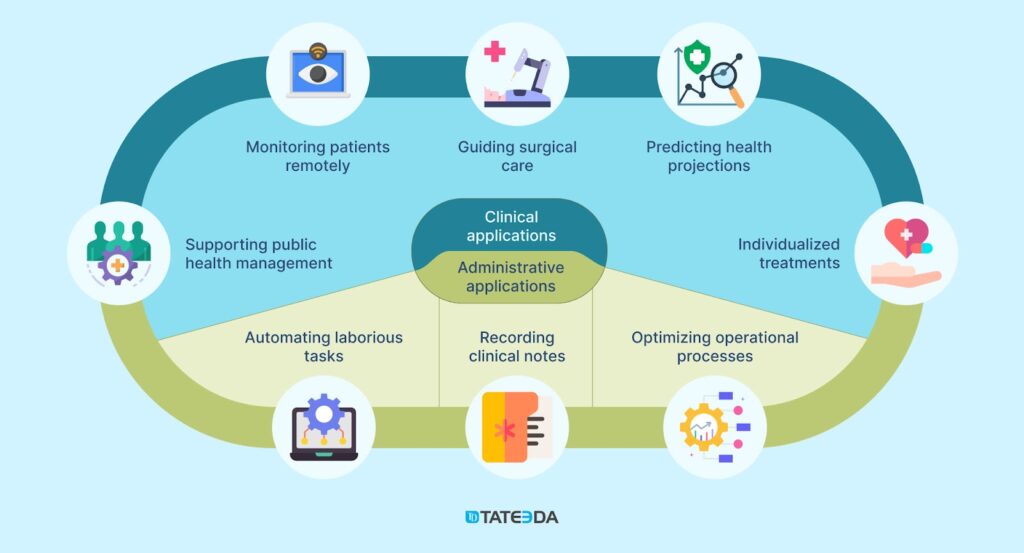
“The sheer scope of the government’s commitment to digital health is extraordinary—whether it’s streamlining data sharing through EHRs or fortifying cybersecurity measures, these efforts ensure that technology translates into better care for all.”
— Ingvar K., TATEEDA’s Software Architect.
Together, these policies and investments form the backbone of a rapidly evolving digital health ecosystem. By addressing persistent challenges (like interoperability and security) while pushing innovation forward, the U.S. has cemented its leadership in healthcare IT, further bolstering its digital health market share and global influence.
Rapid Growth in User Base Across eHealth and Digital Wellness Solutions
The adoption of digital healthcare solutions has seen consistent growth in healthcare technology statistics, with a remarkable forecast for 2027:
- eHealth: Expected to lead with 2.9 billion users globally, eHealth refers to using digital tools and platforms to improve healthcare services and management. This includes electronic health records (EHRs), different telemedicine integration strategies, online health consultations, and mobile health app trends, all aimed at making healthcare more accessible, efficient, and patient-centric.
- Digital Fitness & Well-Being: Anticipated to exceed 1 billion users, demonstrating its expanding appeal through fitness trackers, wellness apps, and virtual coaching platforms.
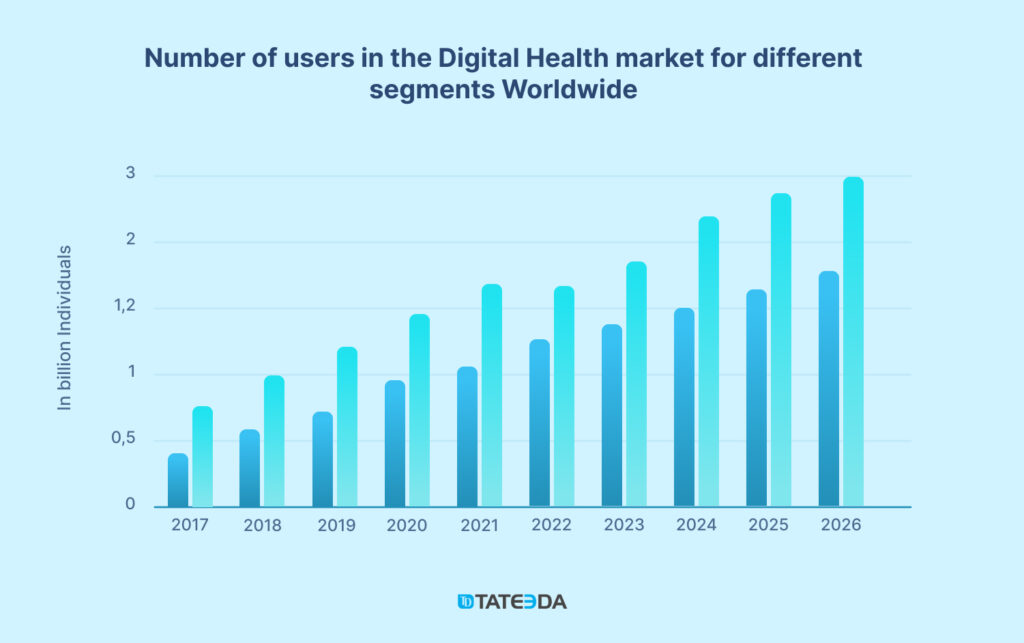
Revenue Growth Across Healthcare Segments
The global healthcare tech market size is undergoing a fundamental expansion, with revenue projections showcasing the vast potential of healthcare IT solutions. From wearable devices to AI-driven diagnostics, these technologies are transforming healthcare delivery and management, driving unprecedented financial growth across key segments.
Revenue forecasts for 2027 highlight this trend:
| Segment | Forecast Revenue (2027) | Key Technologies Driving Growth |
| Global Healthcare IT | $974.5 billion | AI, cloud computing, EHRs, telemedicine, big data analytics |
| Digital Fitness & Well-Being | $146.83 billion | Wearables, fitness trackers, wellness apps, virtual coaching |
| Remote Patient Monitoring (RPM) | $67.1 billion | IoT devices, connected health solutions, data analytics |
| Telemedicine | $185.6 billion | Virtual consultations, AI-driven diagnostic tools |
| Electronic Health Records (EHRs) | $99.9 billion | Cloud-based record systems, data integration platforms |
| mHealth Apps (Mobile Health) | $108.3 billion | Health tracking apps, patient engagement tools |
| Pharmaceutical IT Systems | $72.4 billion | Supply chain management, AI for drug discovery |
| Healthcare Big Data Analytics | $68.7 billion | Predictive analytics, population health management |
| Hospital Information Systems (HIS) | $110.2 billion | Workflow management, patient administration systems |
The rapid growth across these segments reflects the increasing adoption of advanced technologies like telemedicine platforms, remote patient monitoring systems, wearable devices, AI-driven diagnostic tools, and cloud-based healthcare solutions. With a compounded annual growth rate (CAGR) of 19.8% from 2022 to 2027, healthcare IT is solidifying its role as a cornerstone of the global economy.

Final Word: Staying Ahead in the Healthcare IT Market
At TATEEDA GLOBAL, we remain vigilant, monitoring healthcare IT market trends and digital health statistics to ensure our offerings align with the latest industry demands. By staying current, we consistently provide cutting-edge, custom health solutions tailored to the evolving needs of our clients. As a leading healthcare IT consulting company, we assist healthcare organizations in navigating the evolving digital landscape.
The healthcare technology landscape is fast-paced and dynamic—requiring expertise and innovation to deliver impactful, reliable results. We are here to guide you!
Are You Looking for Help with a Custom Health Solution?
Whether you’re seeking custom platforms or advanced integrations, our team is ready to collaborate to ensure future-proof success in this rapidly growing industry.
From patient payment portals to pharmacy claims processing platforms, our case studies demonstrate our proven expertise in health-tech solutions:
Patient Payment Portal Development
| Client | A US-based medical service provider |
| Challenge | Creating a secure, web-based portal to simplify patient payments and ensure compliance with healthcare regulations. |
| Solution | TATEEDA developed a flexible portal supporting billing options like credit cards, debit cards, and ACH payments. The platform includes customizable payment plans and recurring payment features. |
| Result | Streamlined billing processes, reduced administrative burdens, and 24/7 secure patient access to account management. |
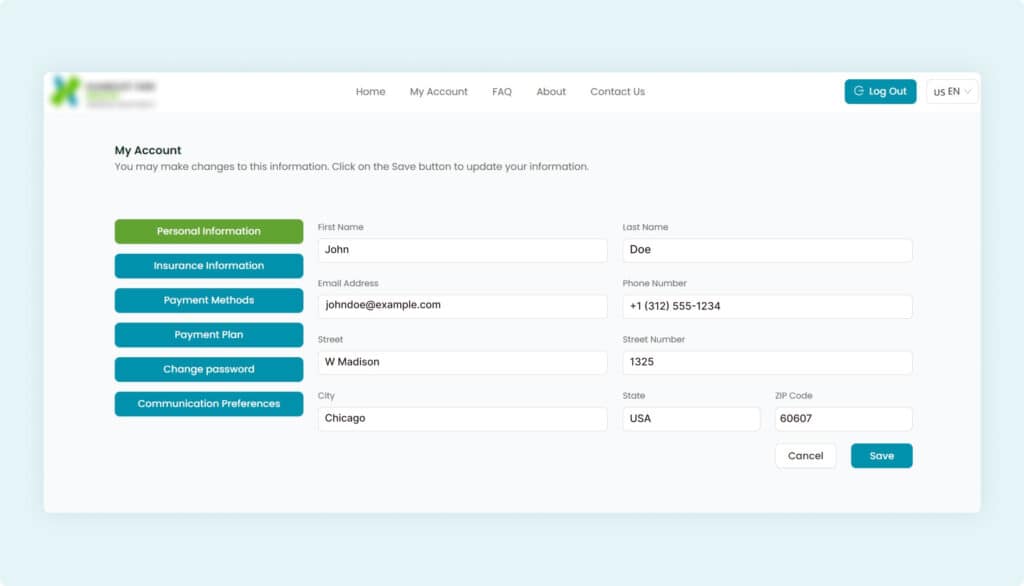
Pharmacy Claim Processing & Medication Fulfillment for SCRx
| Client | SCRx Pharmacy, a leading pharmaceutical distributor |
| Challenge | Automating drug orders, claims processing, and medication distribution to improve operational efficiency. |
| Solution | Enhanced back-end development with API integration, bulk PDF import, and OCR functionality for claim automation. |
| Result | Reduced manual workloads by fivefold, improving accuracy and efficiency across operations. |
